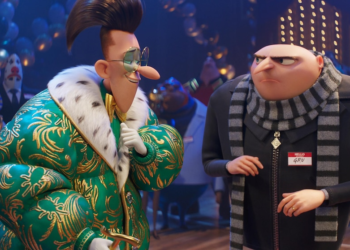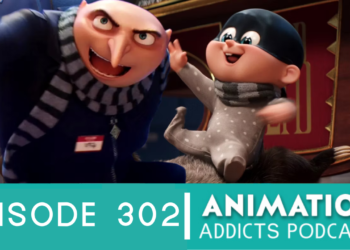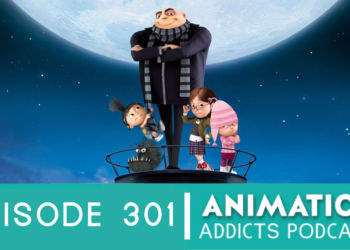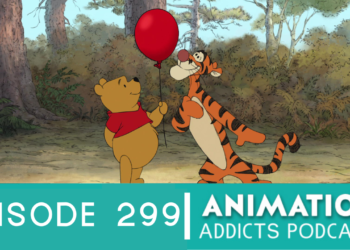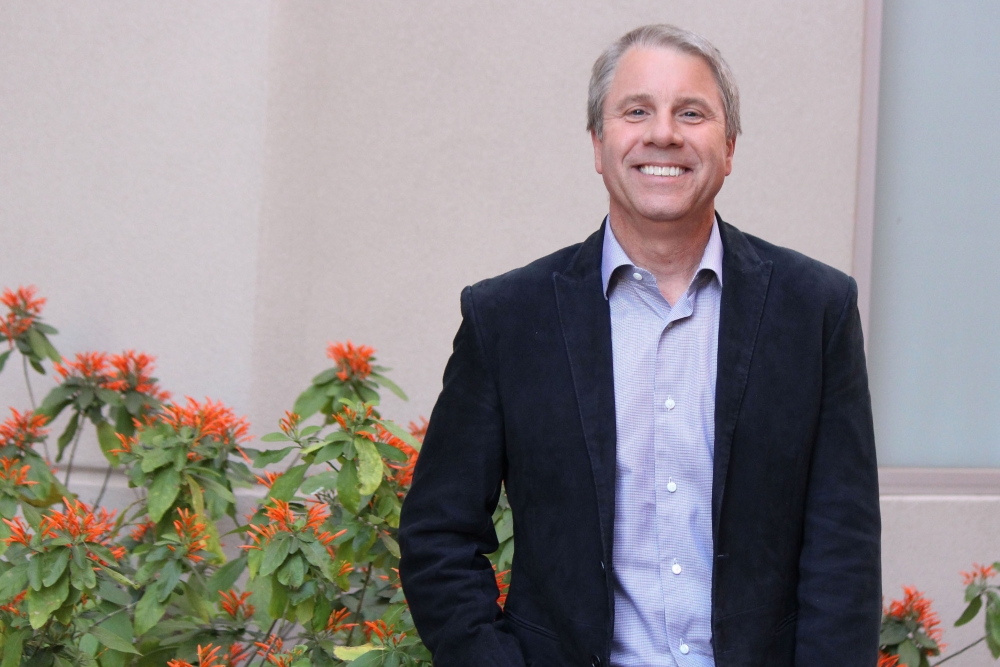
Disney has an long-established legacy of being a leader in the feature-length animation industry, especially with its recent series of hits over the past few years such as Frozen, Tangled, and Wreck-It Ralph. The studio’s newest release, Zootopia, promises to be yet another hit and beloved addition to the Disney canon.
In Zootopia, Judy Hopps (Ginnifer Goodwin) is an eager new member of the Zootopia police department, who also has the honor of being the first bunny to join the squad. However, her dreams of being a hero are staunched as her biased boss assigns the new recruit to write parking tickets all day long. With the help of a con artist fox Nick (Jason Bateman) her luck changes when she stumbles on a clue, allowing them to investigate a series of disappearances across the city.
To celebrate the film’s release, Zootopia producer Clark Spencer sat down with the Rotoscopers and some of our fellow film journalists for an interview to discuss the film, his role in creating the world of Zootopia, and the tough changes they made to make the film better.
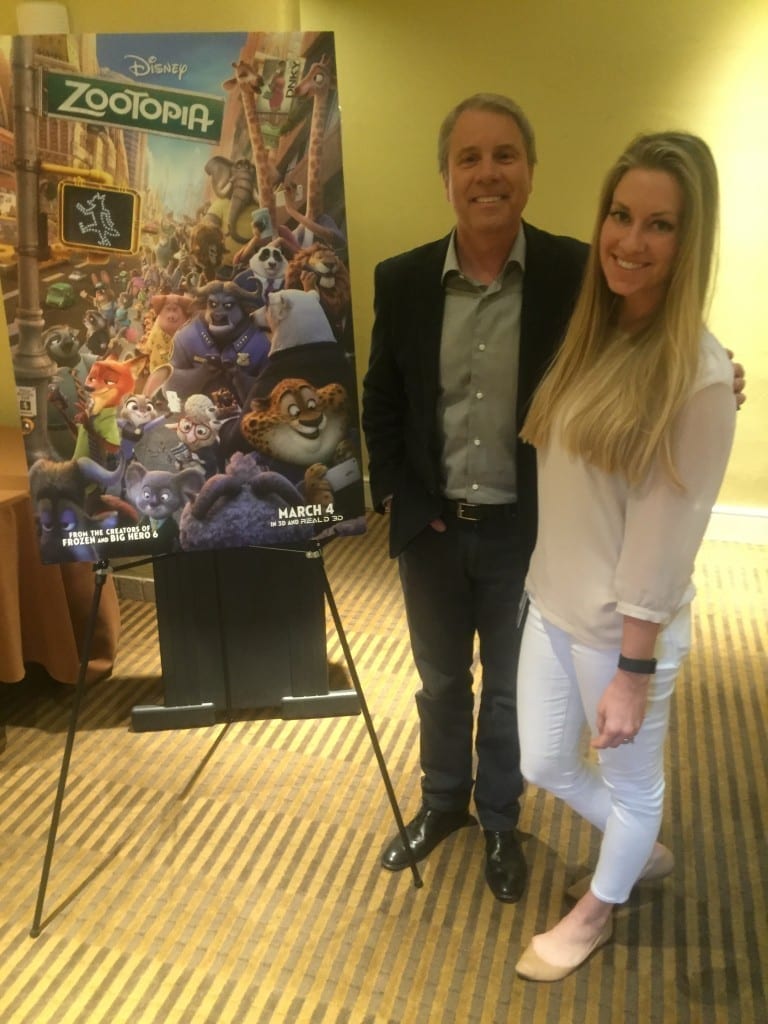
This film seems to be coming out a very prophetic time because of the subject matter and looking at what we are dealing with with our current political climate, it feels like this film couldn’t be coming out at a better point to really have this message be impactful. Obviously, the development cycle on a movie like this is a little bit longer, but at what point did you realize that “Hey, we may have something that is going to hit harder than we anticipated?”
Clark Spencer: The project was started five years ago by one of the two directors, Byron Howard. He had finished Tangled, and he was pitching this idea. And at that time, he actually didn’t have the theme. He really just said “An all-mammal world, where humans never existed, but animals evolved and used our own technology.” And John [Lasseter] loved the idea. And then in doing the research, when we went out to Africa, we learned this incredible statistic, which is that 90 percent of animals in the natural world are prey animals, and 10 percent are predators. We never thought about that as an idea, or even as a fact, but it makes sense–more prey animals than predators.
And we thought, what an interesting dynamic, where you have one really large group and one really small group, and they have to figure out how to coexist. And especially if we say to ourselves, they’ve evolved past eating each other, and now the question is “Do [the prey] actually believe that they’re completely safe? Will the prey animals still worry deep down inside?” That’s where the theme started to come in, and that came in about a year later – so four years ago, we’re starting to get that idea of what the theme for the film could be.
But it wasn’t really until about the last nine months that we started to say to ourselves, “It’s incredibly interesting how this idea that was started five years ago is starting to feel like it’s coming at a moment in time where there’s a lot of those things around the world.” Now, we always knew, thematically, that this is an idea that would be universal because I think it is just a universal thing. But in terms of where we are alright now, it’s incredibly profound. You never could have timed it. It’s a world confluence of events that just all lined up.
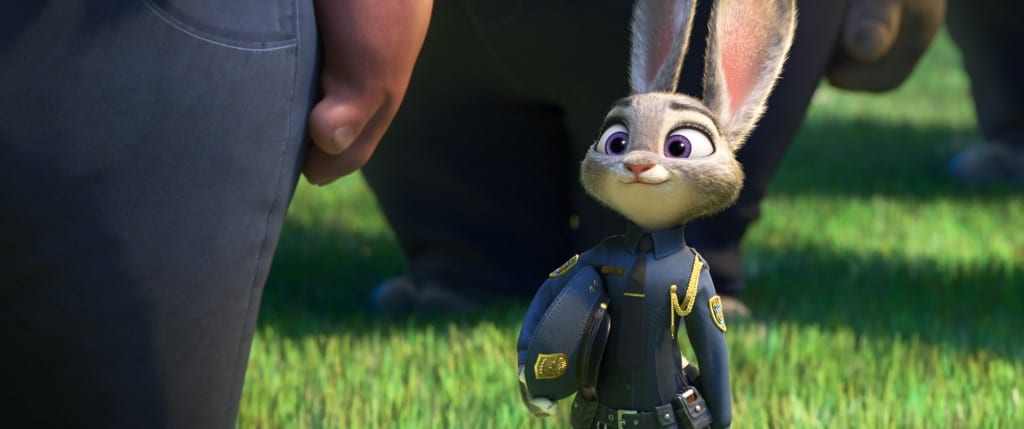
I feel that the best Disney films have managed to be perennial while also keeping up with modern times and Zootopia is no exception. How do you think that Disney manages to keep consistently timeless and timely?
Clark Spencer: It’s hard. It’s really, really hard. And I feel, I have to be honest, I feel very luckily that all of the films I’ve worked on take place in the modern world. I’ve produced Lilo & Stitch, Bolt, Wreck-It Ralph and now Zootopia–and they all take place in a world, even if it’s in an all-animal world, it’s still a modern, evolved world. I’ve not done a fairy tale. As a result, I get the great luxury of having artists think about “How do we create that world and have fun in it,” where it does feel very timely, but also hopefully timeless.
So the story, characters, and the theme have to be timeless in some ways, some of the ideas in there can be timely, if you will. We obviously have ads in there. We have Zuber instead of Uber and in 30 years, who knows what that new thing is. We have a carrot on the back of a phone instead of an apple, and in 30 years, who knows what that actually is. But we can have fun with those parts of it and that’s one of the things that I feel very fortunate to have been work on these films; you get to work with teams that are just having fun thinking about: “What else can we do?” “What are the other ads that can be in this world?” “What is the other technology?” “How can we put the animal spin on something we all know that allows it to be relevant and relatable for us, but ultimately allows the audience also to have fun–especially for the adults?”
We’re trying to create movies for everyone. We don’t want it to just be parents who have kids. We really want it to be for teenagers, for the date crowd, for the people who don’t have children–we want to tell these really entertaining stories. This allows us to do that to have it play at two different levels for kids and adults.
This movie is for all ages. I saw a lot of happy faces, young and old, coming out. How do you balance the whimsy of an animated story with something like a detective story, which is for adults?
Clark Spencer: It’s not easy. We’re always trying to figure how to do it for people of all ages, and it’s not science – you can’t sit there and say, “Well, we must have 50 percent of the jokes for parents, and 50 percent for kids. And we know this will play for 14-year-old and we know that will play for a 30-year-old.” You can’t do it, there’s no science to that, but at the end of the day we have to look and say, “What makes us laugh?” And hope it also makes the kids laugh, because it can’t be too esoteric and it can’t be too deep.
So when we look at a scene like the DMV, we know that for adults it’s going to play great because they’ve probably had that experience. Now the kids haven’t yet, but they’re going to think the sloth looks funny, and the sloths sound funny because they’re talking slowly. So we hope that both can enjoy that scene together.
When it came to the police procedural and having this sort of mystery in it, that was a really interesting thing that came up early on in terms of the pitch that the writer and the directors had, “Let’s put a mystery in this film.” We hadn’t done a mystery in a long time–The Great Mouse Detective was really the last one–and it was really complex. And I’ll tell you there were times when we said “Should we lose the mystery?” Because the mystery would get so complex that you would get lost in trying to figure out the mystery, and forget about the theme of the story is, and these characters because we really have many different things weaving into this film.
But I’m so thankful that the directors never let that idea go, that they really fought hard and said, “Well, no. Our job is to figure out how we do we get the mystery to be interesting enough to get caught up in it, and simple enough that we can understand it.” We had to test the film many times. Ultimately because we wanted to see with an audience, “Are they tracking the mystery?” And we did several more preview screenings with outside audiences after that [initial test screening] because we learned things from that screening and said, “Okay, what level have we gone too deep? And what place are we not deep enough?” So it was one of those things where we had deep conversations about it.
But now I’m so proud of keeping that in there, because I think it’s one of the layers that’s unexpected. People come in and see an all-animal, talking animal film and have one expectation: they think they are going to laugh, hopefully they think they are going to have emotion, but they’re not expecting a mystery to get layered in there. They’re not expecting that buddy cop kind of comedy that it’s there.
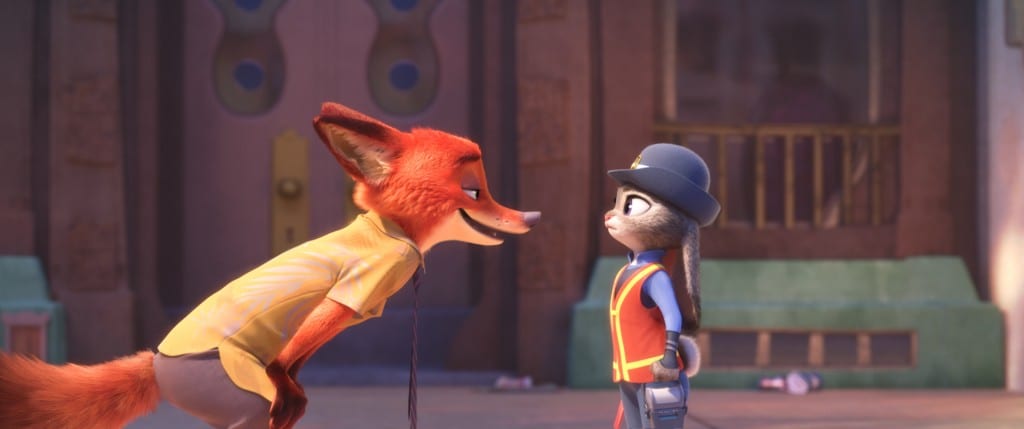
The film has this kind of “film noir” feel. It has shades of Chinatown and The Maltese Falcon, which add an additional layer for adults that want something a little deeper in their animated content. Were there specific influences you drew from to put those things in there or was it a kismet sort of thing?
Clark Spencer: Oh, absolutely, we looked at those two films in particular. We also looked at Frank Capra’s films for the Judy character. We looked at great films that have been made to give us those kinds of inspiration.
And when we were talking about the police procedural, the visual development artist said “I’d love to have a film noir feel to it.” And that’s kind of what said to us that we should go look at those movies and see, “How are they pulling that off? And at what point are we giving enough information for the audience to track.” It’s a very interesting genre, and it gives another layer into the film and allows you to start to see those elements that we remember from amazing movies.
WARNING: SPOILERS ABOUT A KEY SCENE BELOW.
Using The Godfather, as an example. That was another one where we said to ourselves, “We could have fun.” Someone pitched out an idea that we need to have a scene where the characters are going to meet the mob boss of Zootopia. “Well who is that? Well, maybe it should be a polar bear? Well, what if it was an actually arctic shrew? What if the arctic shrew was actually more of a Marlon Brando type character?” “What if, we just took the scene from The Godfather, almost line for line and have somebody come in and deliver those lines?” If you hear those lines not sped up–it is an actor literally imitating Marlon Brando. Now speed it up, make it feel like an arctic shrew, and see what that gives you. We’re telling the story, but we’re getting to have fun with it too. Not everybody will get those elements, but the kids will laugh because it’s an arctic shrew, it’s a tiny character, the voice is funny. The adults who knew The Godfather will enjoy that aspect of it. And if you don’t, we’re still telling you the story as it goes forward into the mystery. So we have something for everybody.
About a year ago, [the studio] made the shift from having Nick be the main protagonist to Judy. Can you talk about that shift and what the film was like before, with him being the protagonist?
Clark Spencer: The original version, when we were developing it, we did have Nick as our main character. Nick is obviously a cynical character–it was still Jason Bateman and it was still that character you see on the screen–and to us, there was something fun about going into the world with a cynical character, especially with Jason Bateman narrating that character and being that voice. But what we started to realize–and now when we go back in retrospect, it makes so much sense–but what we started to realize was that even if the movie was super funny, people weren’t rooting for Nick because he’s cynical. It’s very hard to get the audience to root for a cynical character. And we would tell the audience, much later in the film, why he was cynical – but it was too late. It was very late in the film for you to suddenly say, “I’m rooting for this person.”
So we had a big screening where we talked deeply about “What if we took it and switched it?” And there were two things that came out of that: one was that it was going to be easier to root for Judy as a small rabbit wanting this dream, it was going to be easier for the audience to want to root for her. But the more interesting thing was that we were going to love the world of Zootopia more. If we learn Zootopia through the eyes of a cynical character, we start to think the world is already broken, from the beginning of the film, from the first few lines. A really profound statement that was said was, “I love this world. You talk about this city, and there’s Tundratown and Sahara Square, and it feels like the most magical place in the world, and yet your main character is telling you it’s broken. So from the beginning, I’m waiting for the world to get fixed.”
If you start from [Judy’s] POV and we see what she is seeing and we believe anyone can be anything–because that’s all we’ve been told–we’re going to realize over the course of time that it’s actually not that perfect, that there are chinks in the armor, and we’re going to discover it through her eyes.
WARNING: SPOILERS ABOUT A KEY SCENE BELOW.
Now the hardest thing is, there’s that Jumbo Pop scene where Nick and Judy first meet in that elephant ice cream parlor. In that sequence, which was one of the sequences we loved and had been animated. We got to see Jason Bateman play a scam on Judy in the ice cream parlor, where he kept layering on, “This is my kid. And my kid can’t talk. And he can’t hear.” You as the audience are laughing because he is pulling the scam on her. And you are loving it. And Jason Bateman was delivering his lines like no one could; it was amazing. And we would play the scene for people and they would crack up, but the problem was: we knew he was scamming her, and she didn’t. So we were, again, ahead of our main character. One of the hardest things to do was to lose that sequence, which was working brilliantly, and change the movie in this big way. But we knew ultimately had to do that and that was about a year ago.
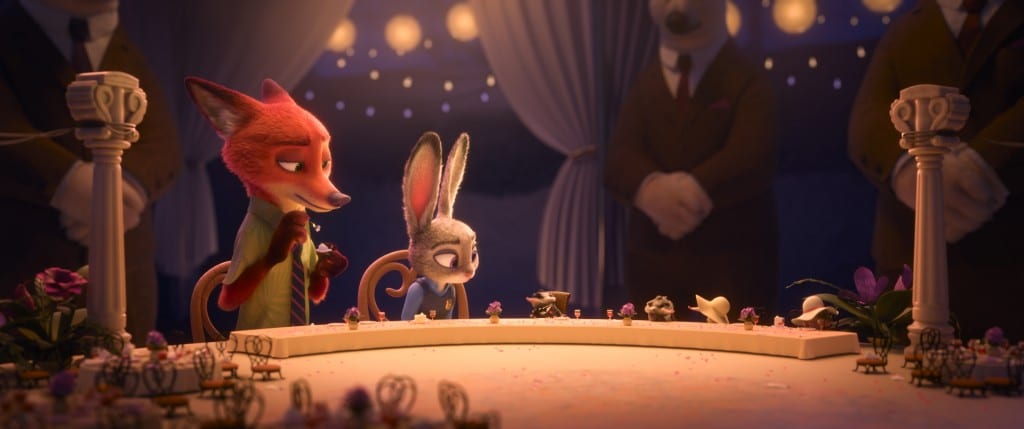
For each animated film, it seems that there’s one big technical hurdle you have to overcome. For Tangled, it was the hair, and for Frozen it was the snow. What was the big technical hurdle for Zootopia?
Clark Spencer: The big one for us, and it has multiples levels, is fur. Fur was a huge one for us. When we do characters with hair, everybody has the same hair. In other words, once we create one strand of hair, we can put it on any character–give it a curl, give it a different color, make it straight–we can create variety through that. But animal fur is different for every single species of animal, and there are 64 different species of animals in this film.
So we studied those 64 different species’ fur under a microscope to understand what was different about each one. Polar bear fur is actually clear–it’s not white–and the light that goes through it creates a reflection that makes it appear to be white. Fox fur is dark at the root, and gets lighter as it goes to the tip. Sheep’s wool is so thick that it’s filled with dirt and twigs, so if you look at any of the sheep in the movie, they have dirt and twigs in it. An arctic shrew’s fur is very soft. An otter has a little bit of oil on the fur.
So we had to create technology that would allow us to create each one of those different types of strands of fur. A giraffe in this film has 9.2 million fur strands on it; 2.6 million on the rabbit, Judy; 2 million on Nick himself. So you start exponentially thinking about how you have to go in and do all that. And then we have to create new shader technology that would allow the lighting system to understand how it’s supposed to react to each of those different types of fur. Because it’s going to react differently to a sheep’s wool, that’s very thick, than it is to the softness of the arctic shrew – so it just kept layering on top of layering.
And then we’re going to put clothes on those animals, and the clothes have to move in a way that feels realistic. We’re going to have an elephant be as tall as a real elephant, and a mouse be as small as a real mouse, so they’re going to move differently on something very tiny, and on something very large. So it really just exponentially built, but it all started with one key thing, which was we wanted the fur to look realistic. We didn’t want to use human hair, which is what we’ve always done. If you watch the movie Bolt, I’ll be honest, it’s human hair that we’ve made look like animal fur. In this case, we wanted it to be actual strands of fur for those 64 species.
During the initial tour of Zootopia, we saw mountains, we saw a city, we saw snow, we saw a body of water. It’s a very unique environment. What was your inspiration in creating the city of Zootopia?
It’s interesting because we studied a lot of cities. We actually went to New York city and studied with a historian and understood that when they started to land on the island of Manhattan and different ethnicities–Irish, Chinese, Italian–all came in, how did that start to grow in downtown Manhattan? And how does Chinatown and Little Italy sit next to each other? How do those groups coexist? We looked at Paris. Paris being a city where everything spirals out. And we said, “Well, we have a downtown area and everything is going to come out of that.” We even looked at Disneyland and the Magic Kingdom down in Orlando and said, “There is a castle and then there is these lands that go around it.” We really started to think about that aspect.
But the most important thing, and we learned this in Africa, was that it all needs to start from a watering hole. And even though we don’t see it in the film, in the central part of town, there is a watering hole where the fountains are, and that’s where all the animals gather. So to us, that was the origins of the city of Zootopia and then everything built from there. Which is how all cities start: they start usually by a body of water. So, again, we don’t call it out. But that was our way of thinking about, “How does a city get built?”
Then we did research. That’s one of the things John Lasseter, who is our boss, always challenges us, “How does this actually work?” So we would have experts come in to say, “How can these different environments exist?” And we met with a really important expert who talked about air conditioning units. And there’s a huge wall that divides Tundratown, the cold area that divides Sahara Square, you see it in the film, the train goes through it. It’s an air conditioning unit. He said, “If you had enough money, you could built a big enough air conditioning unit.” All air conditioning units do the same thing: blow out hot air on the outside, blow out cold air on the inside. Cold air creates Tundratown, hot air creates Sahara Square. And then, the melt off from Tundratown creates the Rainforest District. And again, at one point, we actually said that in the movie and it felt important, but it wasn’t helping tell the story. So we don’t do that, but there is true logic to how these environments sit next to each other, in a way that could technically, as the expert said to us, “If you had enough money and enough wherewithal” you could actually create that kind of a world and make it happen.
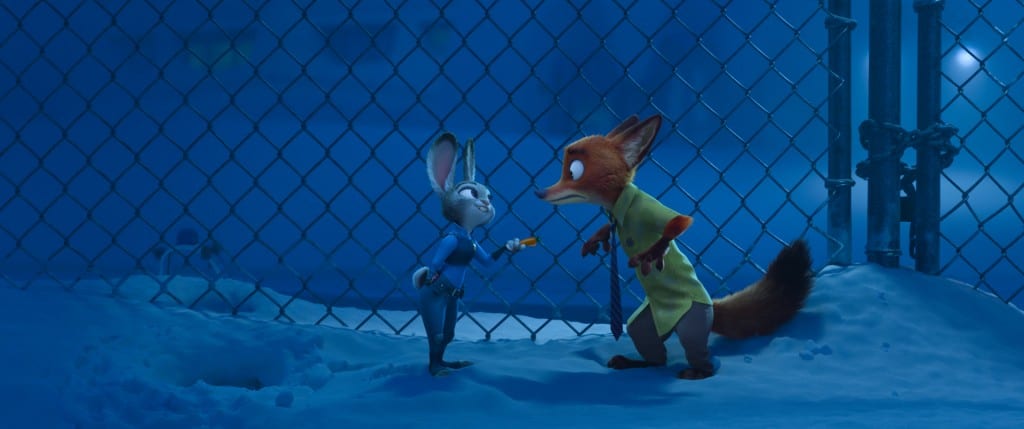
At the Disney Animation Building in Burbank, each of the department’s decorate their pods in the theme of the movie they’re working on. What about that helps foster the creative process? And what were some of the things in the pod to get everybody in that mindset?
I think for us, what I love about the concept of theming the pods, is that it does sort of say, “This is the next movie that this team is creating.” And it does allow us to be fun. We’re always trying to create a very creative, open environment. A building is a building. So we got to put some layer of creativity onto it, and so for each of our films, we go in and decorate them deeply.
So the interesting thing about Zootopia is that we are renovating that animation building in Burbank, CA. So we had to move out of the building and go to a warehouse in North Hollywood. This warehouse is at the end of the Burbank airport, so you’re right next to a runway; there is a train track that goes literally next to the building; there’s an impound car lot right outside this warehouse building. It’s not the nicest part of North Hollywood. And it is a big massive, open warehouse, where when you walk in, you feel like, “How are we ever going to make any environment that makes you feel like you are in Zootopia or you are making a movie in Zootopia?”
But it didn’t matter because the cool thing was: we were all moving to a new space together to work for 18 months. And we bonded like we have never bonded before because the only people in that building were people working on Zootopia. We had to split among three different buildings. So the decision was made that all of Zootopia would go in this one warehouse. It is one sea of cubicles and there are no offices–basically, there are five offices where everyone had to share, but other than that, everyone was in a cubicle. And what it did was that it created a really open, communicative environment because people could see what everyone was doing. No one had the ability to use a cubicle wall to hide behind what they were doing, everybody got to share.
So the best we could do was we created a huge mural. There’s a huge open bay–it’s two stories tall; a massive, massive wall–where we painted Sahara Square on it. We had an artist team come in from Imagineering, the people who do the parks, they painted all of Sahara Square on that. And that was sort of our big statement. When you walk into this space and you see Sahara Square that has been painted up there and that was kind of the best we could do. It was this big warehouse and there was no pod to theme. But I loved working there. I really thought it created an energy that I haven’t felt for a while. So I was super excited that I got that opportunity to do it. So for us, it was a bit of a different story. But we do [theme the pods] because we want to create an environment and let people think about the fact, “Now we’re in San Fransokyo.” “Now we’re in world of Norway.” For Zootopia, it would have been figuring out how do we create all these districts that the animals are coming from. Secretly, I would have loved a ton of animals in the building, but that would have taken a whole different team of people just to be responsible for the animals.
What do you think your greatest personal contribution to the film was overall?
Clark Spencer: You know, it’s interesting. I think one of the big things is, and I try to always hold onto this, it’s something someone told me when I produced my first film, Lilo & Stitch. I had never produced a film ever in my life, I came from the finance side of things. I was given this amazing opportunity and I sat down with a woman who I really respect, and I said “as a producer, how do you think about it?” And she said “the most important thing to do is think about what’s the best story. Because everyone is going to be telling you, ‘Remember, you have a budget. Remember, you have a schedule. Remember, you only have so many people working on your film.'” If you do that, you can check the box. Hit the schedule. Hit the budget. Hit the number of employees. You won’t be able to check the box that you made a great movie.
And what’s important about that is to know in those moments and a year from finishing this film, when you start talking about the idea that you’re going to take your main characters and flop them. You’re going to tell Jason Bateman he’s not the main character, you’re going to tell Ginnifer Goodwin she has to re-record most of the movie so that she can now be that main character. You’re going to throw out animation that’s done. You’re going create new characters, like the sloth–that’s when the sloth scene came into being. Your instinct is to say, “We can’t do it. There’s no way we can do this. In a year? We are kidding ourselves.”
But I knew the story wasn’t going to be the best story possible. So for me, I think [my best contribution] in that moment in time was not panicking, not telling the directors that we can’t and letting the directors go and start building that story to see if it was truly going to be better than the Nick version of that story. I always knew we had that sitting on the shelf, and we could go back to that if this other idea wasn’t right. But in the moment, I had to let the team creatively have an opportunity to see what this would look like.
So as I look back, I think this is completely the right version of the story to be told. And I think that was the biggest thing I did for the film: just relax, and not panic.
Disney’s Zootopia is now playing in theaters. Check out our review of the film here.
Edited by: Hannah Wilkes


